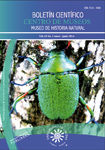Authors
Abstract
Creole hens in Colombia have not been characterized or categorized satisfactorily, being their productive flair as well as their diverse phenotypic features almost completely unknown, reason why preserving the native strain becomes a priority, especially because of their habitat destruction and the scarce knowledge of these strain which place the native genome at extinction risk. The genetic material of the country has its origins in the Gallus bankiva (Gallus gallus ssp.). This research was carried out in the influence zone in the rain forest of Florencia in Samaná, Caldas. The totality of creole mature hens and roosters found in farms of the region was analyzed to obtain the categorization and characterization. Information was gathered in a survey form integrated by qualitative and quantitative variables in which the phenotypic feature of the hens was registered. A multivariate analysis was used to group the individuals through the multiple correspondence methodologies in the SPAD.N statistics program that allows bringing together similar individuals with similar characteristics in homogeneous groups. As a result of the analysis, seven factorial axes were obtained and five resultant groups that explain the 70% of variance, analyzing 47 active variables which grouped 98% of the animals. The main phenotypic features were: feathers' color, eyes, beak, crest form, size, and body weight. Group one was the one with brown birds with the gold gene effect (ss); group two was dominated by color black representing 26% of the population that was analyzed; the third group was made of the 11% of the population formed by white birds with the (c/c) gene; group four gathered the 11% of the yellow or blond individuals; and lastly, group number five got together birds with barred plumage by the presence of the Barred (B-b) gene. In the rain forest zone in Florencia, creole phenotypes with dark plumage take precedence as they are less vulnerable to predators; it is a germplasm adapted to the conditions of the region where color brown is dominant.
References
CISIA., 1994. Métodos estadísticos y control de Calidad de Información. SPAD.N Versión P.C. U. Central de Venezuela. Laboratorio de Análisis de Datos.
ESPINOSA, R., 1991. Caracterización morfológica de la gallina mestiza del Estado de Chiapas. Tesis, Universidad Autónoma de Chiapas, Tuxtla Gutiérrez, Chiapas, México.
GARCÍA, R. & LONDOÑO, M., 2002. Palmira tendrá gallina de los huevos de oro. Disponible en: http://elpais-cali.terra.com.co/historico/sep202002/reg/B520N2.html
GARNICA, I.O., 2011. Origen y evolución de las aves. Universidad Nacional de Colombia, Bogotá. Disponible en: http://www.monografias.com/trabajos65/origen-evolucion-aves/origen-evolucion-aves2.shtml
GUINBERT, E. Las estirpes cuello pelado. Revista Acontecer Avícola. 5 (24): 17
INSTITUTO COLOMBIANO AGROPECUARIO (ICA)., 2008. Protección animal. Vigilancia epidemiológica. Censos. Disponible en: http://www.ica.gov.co/getdoc/8232c0e5-be97-42bd-b07b-9cdbfb07fcac/Censos-2008.aspx
JUÁREZ, C., MANRÍQUEZ, A. & SEGURA, C., 2000. Rasgos de apariencia fenotípica en la avicultura rural de los municipios de la Rivera del Lago de Pátzcuaro, Michoacán, México [en línea]. México: Universidad Michoacana de San Nicolás de Hidalgo, Morelia. Disponible en: http://www.fao.org
JUÁREZ, A. & ORTIZ, M., 2000. Estudio de incubabilidad y crianza en aves criollas de traspatio. Veterinaria México, 32 (1): 27-32.
LAYNA, L. & ORDÓÑEZ, M., 1982. Las aves: 1325-1326 (en) Enciclopedia ilustrata di animali. UTHEA, S.A. de C.V., Londres.
MATISOO, E., 2007. Radiocarbon and DNA evidence for a pre-Columbian introduction of Polynesian chickens to Chile. Proceedings of the National Academy of Sciences of the United States of America, 104 (25): 10335-9. Universidad de Auckland y Universidad de Chile. Santiago de Chile.
ORGANIZACIÓN DE LAS NACIONES UNIDAS PARA LA AGRICULTURA Y LA ALIMENTACIÓN (FAO)., 1981. Descriptores de especies avícolas: 13-15 (en) Banco de datos de recursos genéticos animales. Roma, Italia.
--------., 2000. Una tercera parte de las razas de animales de granja corre peligro de extinción. Noticias FAO del 5 de diciembre de 2000. Disponible en: http:/www.fao.org
OROZCO, F., 1989. Genética de caracteres cualitativos: 30-40 (en) Razas de gallinas españolas. Mundi-Prensa, Madrid, España.
PATIÑO, V.M., 1970. Plantas cultivadas y animales domésticos en América Equinoccial. Animales domésticos introducidos. Tomo V. Imprenta Departamental, Cali, Colombia. 320p.
RIVERA, O., 1995. Análisis cronológico de la industria avícola colombiana (en) XV Jornada de Medicina Veterinaria y Producción Animal. Facultad de Ciencias Agropecuarias, Universidad de Caldas, Manizales.
SEGURA, C., 1989. Rescate genético y fomento avícola de las aves indias o criollas en México: 44-46 (en) Memorias de la Primera Reunión Sobre Producción Animal Tropical. Cárdenas, Tabasco, México: Centro de Enseñanza, Investigación y Capacitación del Sureste.
SEGURA, J. & MONTES, R., 2001. Razones y estrategias para la conservación de los recursos genéticos animales. Revista Biomédica, 12 (3): 196-206.
VALDÉS-CORRALES, R.J., PIMENTEL, O., MARTÍNEZ, K. & FERRO, E.M., 2010. Caracterización fenotípica del genofondo avícola criollo de San Andrés, Pinar del Río, Cuba. Archivos de zootecnia, 59 (228): 597-600.
VALENCIA, N.F., 2011. La gallina criolla colombiana. Universidad Nacional de Colombia, sede Palmira, Valle. Facultad de Ciencias Agropecuarias. 61p.
VALENCIA, N. & BETANCOURT, L., 1991. Origen, desarrollo y descripción de los tipos de gallina criolla existente en varios municipios del Valle del Cauca. Tesis de grado, Universidad Nacional de Colombia, Palmira. 120p.
VARGAS, J., 2011. Estudio de las características nutricionales y el potencial productivo de recursos campesinos para la alimentación animal en el Valle del Cauca. Cipav, Cali. 49p.

 PDF (Español)
PDF (Español)
 FLIP
FLIP


















